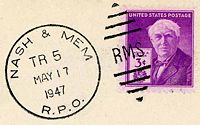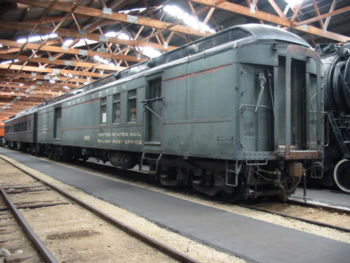Railway post office
2008/9 Schools Wikipedia Selection. Related subjects: Railway transport
In the United States a railway post office, commonly abbreviated as RPO, was a railroad car that was normally operated in passenger service as a means to sort mail en route, in order to speed delivery. The RPO was staffed by highly trained Railway Mail Service postal clerks, and was off-limits to the passengers on the train.
Many American railroads earned substantial revenues through contracts with the Post Office to carry mail aboard high-speed passenger trains. In fact, a number of companies maintained passenger routes where the financial losses from moving people were more than offset by transporting the mail.
History
The world's first official carriage of mail by rail was by the United Kingdom's General Post Office in November 1830, using adapted railway carriages on the Liverpool and Manchester Railway. Sorting of mail en-route first occurred in the United Kingdom with the introduction of the Travelling Post Office in 1838 on the Grand Junction Railway.
In the United States, some references suggest that the first shipment of mail carried on a train (sorted at the endpoints and merely carried in a bag on the train with other baggage) occurred in 1831 on the South Carolina Rail Road. Other sources state that the first official contract to regularly carry mail on a train was made with the Baltimore and Ohio Railroad in either 1834 or 1835. The United States Congress officially designated all railroads as official postal routes on July 7, 1838.
Similar services were introduced on Canadian railroads in 1859. In the United States it was introduced on July 28, 1862 using converted baggage cars on the Hannibal and St. Joseph Railroad (which also delivered the first letter to the Pony Express). Purpose built RPO cars entered service on this line a few weeks after the service was initiated. Its purpose was to separate mail for connection with a westbound stage departing soon after the train's arrival at St. Joseph. This service lasted approximately one year. The first permanent Railway Post Office route was established on August 28, 1864 between Chicago, Illinois, and Clinton, Iowa. This service is distinguished from the 1862 operation because mail was sorted to and received from each post office along the route, as well as major post offices beyond the route's end-points.
In 1869, the Railway Mail Service (RMS), headed by George B. Armstrong, was officially inaugurated to handle the transportation and sorting of mail aboard trains. Armstrong was promoted from a supervisory position in the Chicago post office following his experiments in 1864 with a converted route agent's car on runs between Chicago and Clinton, Iowa.
RPO car interiors, which at first consisted of solid wood furniture and fixtures, would also soon be redesigned. In 1879, an RMS employee named Charles R. Harrison developed a new set of fixtures that soon gained widespread use. Harrison's design consisted of hinged, cast-iron fixtures that could be unfolded and set up in a number of configurations to hold mail pouches, racks and a sorting table as needed for specific routes. The fixtures were also designed so they could be folded away completely to provide a wholly open space to carry general baggage and express shipments as needed by the railroads. Harrison followed through with manufacturing his design at a factory he opened in Fond du Lac, Wisconsin in 1881.
By the 1880s, railway post office routes were operating on the vast majority of passenger trains in the United States. A complex network of interconnected routes allowed mail to be transported and delivered in a remarkably short time. Railway mail clerks were subjected to stringent training and ongoing testing of details regarding their handling of the mail. On a given RPO route, each clerk was expected to know not only the post offices and rail junctions along the route, but also specific local delivery details within each of the larger cities served by the route. Periodic testing demanded both accuracy and speed in sorting mail, and a clerk scoring only 96% accuracy would likely receive a warning from the Railway Mail Service division superintendent.
In the United States, RPO cars (also known as mail cars or postal cars) were equipped and staffed to handle most back-end postal processing functions. First class mail, magazines and newspapers were all sorted, cancelled when necessary, and dispatched to post offices in towns along the route. Registered mail was also handled, and the foreman in charge was required to carry a regulation pistol while on duty to discourage theft of the mail.
Because of the physical and mental demands placed on RPO clerks, the Railway Mail Service pushed the adoption of standardized floor plans and fixtures for all RPO cars, with the first plans published in 1885. The RMS also pressed for greatly improved lighting fixtures to help the clerks to see the addresses written on the mail they had to sort; first by improving the reflectors in the 1880s, then calling for discontinuance of oil lamps in the 1890s and the first experiments with electric lighting in 1912. Clerks' safety aboard the trains where they worked was also of great concern to the RMS with the first comprehensive statistics on work-related injuries published in 1877.
Through the second half of the 19th century, most RPO cars were painted in a somewhat uniform colour scheme regardless of the railroad that owned or operated them. Most were painted white with trim in either buff, red or blue, which made the cars stand out visually from the other cars in the trains where they operated. By the 1890s, this practice had waned as railroads painted their RPO cars to match the rest of their passenger equipment. One RPO car that was displayed at the 1893 World's Columbian Exposition in Chicago is one of the last known examples of the early white colour scheme.
As the development of passenger cars progressed, so too did the development of RPO cars. The first plans for RPO car designs were based on light baggage car frames and bodies, which sometimes resulted in catastrophe for RMS employees when the trains were involved in accidents. The RMS developed its first standards for car design in 1891 to address some of these issues. In 1912, the Railway Mail Service developed a set of strength requirements for new cars in an effort to push the car building companies into using steel for the cars' major structural components and underframes. The core of the requirements was that each car should be able to withstand a buffer force of at least 400,000 pounds. This requirement was doubled to 800,000 pounds in a 1938 revision of the standards. The requirements were again strengthened in 1945 with specifications that precluded the use of aluminium for framing and major structural components. The 1945 revisions also included a requirement for end posts to prevent telescoping in the event of a collision. Car manufacturers adopted these requirements and carried them through to all other models of passenger cars that they built.
An interesting feature of most RPO cars was a hook that could be used to snatch a leather or canvas pouch of outgoing mail hanging on a track-side mail crane at smaller towns where the train did not stop. The first U.S. patent for such a device () was awarded to L.F. Ward of Elyria, Ohio, on January 29, 1867. With the train often operating at 70 miles per hour or faster, a postal clerk would have a pouch of mail ready to be dispatched as the train passed the station. In a co-ordinated movement, the catcher arm was swung out to catch the hanging mail pouch while the clerk stood in the open doorway. As the inbound pouch slammed into the catcher arm, the clerk kicked the outbound mail pouch out of the car, making certain to kick it far enough that it was not sucked back under the speeding train. An employee of the local post office would retrieve the pouch and deliver it to the post office.

Most RPO cars had a mail slot on the side of the car, so that mail could actually be deposited in the car, much like using the corner mail box, while the train was stopped at a station. Those desiring the fastest delivery would bring their letters to the train station for dispatch on the RPO, knowing that overnight delivery would be virtually assured. The mail handled in this manner received a cancellation just as if it had been mailed at a local post office, with the cancel giving the train number, endpoint cities of the RPO route, the date, and RMS Railway Mail Service or PTS Postal Transportation Service between the killer bars. Collecting such cancellations is a pastime of many philatelists and postal history researchers. The Railway Mail Service organization within the Post Office Department existed between 1864 and September 30, 1948. It was renamed the Postal Transportation Service on October 1, 1948 and existed until 1960. After 1960, the management of railway post office routes as well as Highway Post Office routes, Air Mail Facility, Terminal Railway Post Office, and Transfer Office, were shifted to the Bureau of Transportation.
At its height, RPO cars were used on over 9,000 train routes covering more than 200,000 route miles in North America. While the majority of this service consisted of one or more cars at the head end of passenger trains, many railways operated solid mail trains between major cities; these solid mail trains would often carry 300 tons of mail daily.

After 1948, the railway post office network began its decline although it remained principal intercity mail transportation and distribution function within the Post Office Department. There were 794 RPO lines operating over 161,000 miles of railroad in that year. Only 262 RPO routes were still operating by January 1, 1962. In 1942, the United States Postal Service (USPS) began experimenting with a highway version of the RPO to serve the same purposes along routes where passenger train service was not available. These highway post office (HPO) vehicles were initially intended to supplement RPO service, but in the 1950s and 1960s, HPO's often replaced railway post office cars after passenger train service was discontinued. When the post office made a controversial policy change to process mail in large regional "sectional centers," the remaining railway post office routes, along with all highway post office routes, were phased out of service. In September of 1967 the USPS cancelled all "rail by mail" contracts, electing to move all First Class mail via air and other classes by road (truck) transport. This announcement had a devastating effect on passenger train revenues; the Santa Fe, for example, lost $35 million US in annual business.
After 113 years of railway post office operation, the last surviving railway post office running on rails between New York and Washington, D.C. was discontinued on June 30, 1977. Ironically, the last route with a railway post office title was actually a boat run that lasted a year longer. This Boat Railway Post Office was the Lake Winnipesaukee RPO operating between The Weirs, New Hampshire, and Bear Island (New Hampshire), on Lake Winnipesaukee. The final date it operated with a postmark was September 30, 1978.
Preservation
Many RPO cars have been preserved in railroad museums across North America; some of the cars are kept in operational condition. In 1933, Chicago, Burlington and Quincy Railroad rebuilt one of its baggage cars into a replica of the first RPOs that were used on the Hannibal and St. Joseph in 1862. The railroad displayed the car in several cities along the railroad; it now resides at the Patee House Museum in St. Joseph, Missouri.

